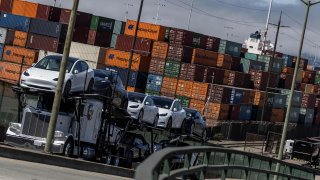
- Economists expect the economy grew just slightly in the second quarter, and some expect that it actually contracted.
- Temporary trade disruptions and the impact of Covid-19 on the supply chain are believed to be behind some of the decline.
- Economists are quick to point out that even if there are back-to-back quarters of negative growth, it does not necessarily signal a recession, as it often does.
Economists are forecasting the economy barely grew in the second quarter, and some expect that it actually contracted.
The estimates show the economy may have grown by several tenths of a percent. Goldman Sachs expects a 1% increase, while Moody's Analytics sees a 1% decline. The GDP report will be released at 8:30 a.m. ET Thursday.
The sluggish growth forecasts follow the 1.6% decline in the first quarter. But there are plenty of forecasts for a shrinking economy, including the Atlanta Fed's GDP Now tracker, which has negative 1.2% for the second quarter.
That would make it the second negative GDP report in a row, one of the signals that the economy is in recession. However, economists are careful to point out that the strong labor market and other factors make a recession unlikely for now. They also note the National Bureau of Economic Research, the official arbiter of recession calls, also is not expected to declare one now.
Fed Chairman Jerome Powell Wednesday said he does not believe the economy is in a recession.
Money Report
"Let's say it's negative. The headline everywhere is going to be 'recession.' That's not how the markets think about it, but you'll see people screaming 'recession,'" said Michael Schumacher, head of macro strategy at Wells Fargo. "Then there will be a debate about it. ... It will matter more to the political types than the market."
Some economists raised their forecasts Wednesday, ahead of the second-quarter report, after the monthly durable goods report came in better tha expected, and advance trade data showed the trade gap narrowed significantly. Durable goods rose by 1.9% in June after a smaller 0.8% advance in May.
Goldman Sachs economists boosted their gross domestic product forecast to 1% from 0.4% after the data.
Mark Zandi, chief economist at Moody's Analytics, said he now has a forecast of negative 1%; before the data it was at negative 1.3%. But he, too, does not believe the negative number, when combined with the first quarter's contraction, would signal a recession.
"I think it's hard to see a recession when we created so many jobs. There are record unfilled positions," he said, noting job growth has been averaging about 500,000 a month. "It's not consistent with the idea the economy is in a recession. It's every single industry and in every corner of the country that is experiencing robust jobs growth. It's just not a recession."
The economy added 372,000 jobs added in June.
Zandi noted the negative growth numbers are likely to be revised higher, and the causes of the contraction are not lasting. The slowdown can be partly linked to the impact of Covid on the economy, which resulted in snarled supply chains and inventory issues.
"The weakness in Q1, Q2 GDP goes to trade and inventories primarily, and those are temporary factors in GDP," he said. "They swing the GDP number around quarter to quarter, but they're not persistent sources of growth or weights on growth."
Trade subtracted 3.2 percentage points from GDP in the first quarter, but it should be a positive factor in the second quarter, Zandi added.
"We had a pretty large inventory gain in Q1. ... I think this goes to disruptions in trade related to the pandemic and the timing of things," he said. "Inventories were up significantly in Q1. ... We're going to see some inventory accumulation in Q2 but not as large an inventory gain. Therefore, that's a drag on GDP."
JP Morgan economists raised their growth forecast from 0.7% to 1.4% following Wednesday's economic releases.
"The most significant surprises were tied to trade and inventories, as the June trade deficit came in narrower than we had anticipated and the June nominal inventory changes were above expectations," the JP Morgan economists wrote in a note.
The nominal goods trade deficit narrowed to $98.2 billion in June from $104 billion in May, and exports rose 2.5% as imports fell 0.5%. The trade data is not complete, as it does not include services, but the JP Morgan economists said they now expect an improving trade deficit means more growth.
"We think the data in hand are strongly suggestive that the real trade deficit narrowed noticeably in 2Q [which we now think added 1.6%-pts to 2Q real GDP growth]," they noted.
Kevin Cummins, chief U.S. economist at NatWest Markets, said the trade data supports his view that the economy grew at a 1.5% pace in the quarter.
"It's not to say you can't get a negative print but it's less likely," he said. Cummins also stressed two negative quarters back to back do not mean the economy is actually in a recession.
"If we get another negative quarter for Q2 they call it a technical recession," said Cummins. "The problem with that is it's not how the NBER looks at things. ... They look at monthly data. They'll look at employment. They'll look at personal income, consumption, industrial production, all the monthly data and decide whether the economy is in contraction or expansion."






